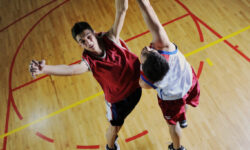
As the leagues finish in football, netball and a host of other team sports, thoughts turn to off-season training, but first – take a break.
When the playing season ends – be it football, hockey, rugby or any other seasonal sport – the first thing you need to do is take some time away to give the body and mind time to relax and recover. Just put down the hockey stick, put away the boots, hide the mouth-guard.
Returning from the off-season in great shape
But, if you want to return to the field after the off-season in great shape then you will also need an off-season training plan.
If you are looking to secure a place in the first team on the first day of the new season then a little bit of preparation during the off-season is a must.
Make the most of your off-season training
Aerobic fitness is vital to team sports and it is one of the fitness elements that you can keep ticking over while your mind and body takes a rest from the mental and physical stress of match play. Do activities such as jogging, cycling, swimming and any variations on these activities, for 30 minutes twice a week. This will keep your aerobic fitness in a good place so you can pick up the pace relatively easily when the season starts.
Add a burst of speed

As the off-season breaks heads towards the new season, with about three weeks to go, you should think about adding some interval training to your regime. Interval training replicates the short, sharp bursts of energy that take place in a match, so if you have not neglected this aspect of your training you will be ready to go when the new season begins.
The basic format is an easy jogging warm-up followed by several high-speed running efforts, followed by short recovery jogs. Aim for a 30 minute session, incorporating at least 15 short sprints of 20-30 seconds. The recovery period between each high intensity effort should be equal in length i.e. 20-30 seconds.
Agility is key to success
With two weeks before the season springs into life, add some speed and agility work into your training. Do a spring session with repetitions of 30 metre sprints with a walk back recovery. Add some change in direction sprinting, maybe place a cone at the 15 metre mark at which point you have to change direction. Also try starting from different positions – kneeling, lying down, facing the opposite direction.
One area that many team sport players can overlook is strength training. A strong core is essential if you are to handle the physical challenges of team sports. Good levels of strength also help you ward off injury. Try to do exercises that are functional and use a number of muscles rather than just working individual muscles. For example, a lunge performed holding a weight uses many muscles; a bicep curl works just the one muscle.
Work with your body weight
Include exercises with weights, such as squats, dumbbell lunges, dumbbell shoulder press and wide lat pull downs, but also include exercises such as squat thrusts and chin ups, that work with your body’s weight.

Stretching is something that you should be doing in both the on and off-season. Yoga, Pilates or simply stretching exercises at home will all keep muscles and joints flexible and reduce the risk of injury.
Add some variety
The final point is that the off-season is a time away from your sport. It doesn’t mean you cannot have a go at other activities. By trying your hand at a different sport, you are keeping your coordination working but using different muscle groups and stimulating your brain to work in a different way. It’s all good for refreshing the body and mind.







